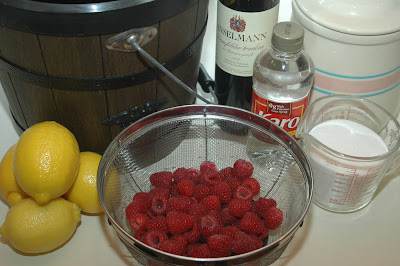Several weeks ago I told you about PFC's Men’s Fellowship Dinner…a manly dinner, cooked for men, by men. Roast beef, baked potato, corn, and pie. It’s what’s for dinner!
Well, the ladies of Parker Ford Church, not to be outdone, have their own dinner…a “carry-in” dinner. That’s right. Each woman creates a dish at home and brings it to the dinner. Seems like a cop out to some of us men, but then again…think about the possibilities of a men-only carry-in dinner. I’m afraid there’d be road kill.
My daughter-in-law, Laura, invited my wife to attend the dinner, and they discussed what food to bring. A pasta salad was decided upon, but as both women are members of the work force, I volunteered to make the dish. I wonder if any of the women attending knew that a dad in the kitchen had contributed to their women’s dinner?
‘Tis the season for pasta salad. With Memorial Day coming up this weekend, pasta salad could be in your future. This recipe has a health and safety advantage over most picnic salads as it does not contain any mayonnaise…or more specifically, any raw eggs. Salads that contain eggs or milk risk bacterial contamination if left at room temperature longer than a half hour. “Dr. Potato,” at the Idaho Potato website, quotes 2005 food code information from the FDA advising that such salads must be kept at 40° or colder to remain safe. As outdoor picnic temperatures are significantly higher than this, always place containers of salads such as potato or macaroni salad in a larger bowl or container filled with ice. You can also simply serve them from a cooler. My friend, Don Trauger, uses an old sand table from his daughter’s pre-school years. The table has a plastic liner that Don fills with ice, and all of the salads are served from it. One word of caution: Pre-school furniture is dog-height!
The ingredients in this pasta salad recipe allow it to be served outdoors without the same level of risk you would have for salads made with eggs or milk. Still, you can’t go wrong keeping any salad in an ice bath or cooler.
Pasta salad is easy to make and the ingredients are basic.
Ingredients:
1 lb. Rotini, spiral pasta
1 head of broccoli, chopped
½ green bell pepper, chopped
½ red bell pepper, chopped
1 pint cherry or grape tomatoes
1 pint cherry or grape tomatoes
½ cup fresh chopped parsley or 2 Tablespoons of dried parsley flakes
Approximately 2/3 of a 16 oz. bottle of Wishbone (or your favorite) Italian salad dressing
Sliced pepperoni
Prepare the water for cooking the pasta. Follow the package directions, and make sure that you use enough water. Do not add oil to the water, as this will prevent the dressing from adhering to the pasta. Adding a half teaspoon of salt to the water will help to flavor the pasta. Rotini pasta is great for this salad as the spiral shape helps to hold the dressing.
While the water is heating to a boil, begin chopping the vegetables. Sometimes, broccoli is not as crisp as it should be. To remedy this, prepare a bowl of ice water. As you cut the pieces of broccoli from the head, place them in the ice water. Usually, within minutes, the broccoli will be much crunchier. Chop the peppers, (and the parsley, if using fresh).
 |
| Immersing broccoli in ice water helps them become crisp and crunchy |
As soon as the water gets to a rolling boil, pour the pasta in a stir. Reduce the heat slightly, keeping the water boiling. Cook the pasta using the al dente timing on the package, which will be a little less than fully cooked.
When the pasta is finished cooking, drain it by pouring it into a colander or strainer. Rinse the pasta in cold water to stop it from cooking. Rinsing also removes some of the surface starch which can cause the pasta to stick together. Allow the pasta to sit and continue to drain while you finish preparing the vegetables. Periodically gently shaking the strainer helps to release remaining water from the spirals.
 |
| Wait to add the pepperoni until you're ready to serve |
Combine all of the ingredients, except the pepperoni and add about 2/3 of a bottle of Italian salad dressing. Toss thoroughly and chill in the refrigerator. This salad is best if made the day before, as the extra time allows everything to marinate. Toss it from time to time to redistribute dressing that has migrated to the bottom of the bowl. Pepperoni tends to get a little funky if you add it too far in advance. When you’re ready to serve the salad, (or ready to get into the car to go to your picnic), add as many slices of pepperoni as you’d like. With the exception of the pepperoni this salad keeps nicely in the refrigerator for several days.
Enjoy…and don’t forget to offer thanks for those whose sacrifices make possible many of the blessings our country enjoys. Happy Memorial Day!












































